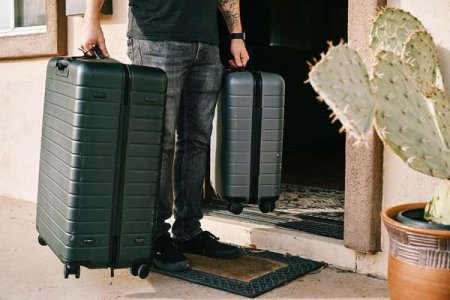This overlooked Qantas rule could be costing you in damaged luggage
Travel nightmares are, unfortunately, a common experience for many of us. However, in this context, we are not referring to the challenges of dealing with a crying child on a long flight or a fellow passenger encroaching upon your personal space by reclining their seat excessively.
Instead, we turn our attention to a more daunting and tangible concern: the harsh treatment our suitcases endure as they make their way through the often chaotic and unforgiving airport environment.
Many travellers have experienced the frustration of suitcases arriving with missing wheels or showing scratches and dents from their journey.

The possibilities for damage are endless as checked baggage navigates its complex path through the airport system.
Let's start our story with Lesley Rogers, a resident of Tasmania.
During her Qantas flight from Hobart to Manila via Sydney, her premium Delsey suitcase suffered a significant blow.
Lesley shared, ‘I put a perfectly good Delsey suitcase on my flight from Hobart to Manila via Sydney, and it came off with a hole smashed in the corner.’
This was no mere scratch or dent that could be disregarded; it was substantial damage that demanded immediate attention and, ultimately, a replacement. The cost of this incident amounted to nearly $800.
Upon reporting the incident to Qantas baggage services in Manila, she was met with a lacklustre response. The damages would not be covered by the airline.
She added, ‘The lady said it was not going to be covered by Qantas. I was leaving the next day for Europe, so I replaced it with the same brand, but a smaller suitcase which cost me almost $800.’
Frustrated yet resolute, Ms Rogers sparked a debate in a Qantas Facebook group.
The question arises: Who should bear the blame for this unfortunate incident? Should we attribute it to the suitcase manufacturer for producing an inferior product, or should the airline be responsible for rough handling?

Not surprisingly, the post garnered many opinions. They flew in from various members, some sympathising with Ms Rogers; others siding with Qantas.
One member commented, ‘It sounds more like an inferior-made suitcase. I would be going back to the manufacturer of the suitcase.’
Another said, ‘Unfortunately, your bag is not wrapped in cotton wool, carefully carried to the plane and delicately placed inside. It travels on several conveyor belts, gets stacked in a bin, is driven to a plane and conveyored [sic] up to the plane. Bags can and will be damaged.’
A frustrating aspect of this suitcase saga is the near-impossible task of claiming compensation.
One member confessed, 'Your damaged suitcase is claimable but a near-impossible process. I'm still waiting even to get a return email from my case from April.'
The Qantas website presents a clear narrative that releases the airline from baggage mishaps.
However, the Montreal Convention of 1999 somewhat contradicts this revelation.
The international treaty outlines airline liabilities, implying the buck stops with them, provided the damage occurred while the baggage was in their custody.
But, of course, there's a catch. The 'gotcha' clause states that the airline is not liable if damage results from an inherent defect or bag quality.

Members, what are your thoughts on the issue of liability for damaged luggage during air travel? Have you personally experienced any instances of damaged luggage during your travels? Share it with us, we’re all ears!
Instead, we turn our attention to a more daunting and tangible concern: the harsh treatment our suitcases endure as they make their way through the often chaotic and unforgiving airport environment.
Many travellers have experienced the frustration of suitcases arriving with missing wheels or showing scratches and dents from their journey.

A passenger flying with Qantas claims that her checked baggage was damaged during a flight from Hobart to Manila. However, when she approached a representative regarding the issue, she was informed that the airline was not responsible for the incurred damage. Source: Facebook
The possibilities for damage are endless as checked baggage navigates its complex path through the airport system.
Let's start our story with Lesley Rogers, a resident of Tasmania.
During her Qantas flight from Hobart to Manila via Sydney, her premium Delsey suitcase suffered a significant blow.
Lesley shared, ‘I put a perfectly good Delsey suitcase on my flight from Hobart to Manila via Sydney, and it came off with a hole smashed in the corner.’
This was no mere scratch or dent that could be disregarded; it was substantial damage that demanded immediate attention and, ultimately, a replacement. The cost of this incident amounted to nearly $800.
Upon reporting the incident to Qantas baggage services in Manila, she was met with a lacklustre response. The damages would not be covered by the airline.
She added, ‘The lady said it was not going to be covered by Qantas. I was leaving the next day for Europe, so I replaced it with the same brand, but a smaller suitcase which cost me almost $800.’
Frustrated yet resolute, Ms Rogers sparked a debate in a Qantas Facebook group.
The question arises: Who should bear the blame for this unfortunate incident? Should we attribute it to the suitcase manufacturer for producing an inferior product, or should the airline be responsible for rough handling?

Damaged luggage in airports can occur due to the complex and often chaotic nature of the baggage handling process, involving multiple conveyor belts, stacking, and transportation methods. Image by convertkit from unsplash
Not surprisingly, the post garnered many opinions. They flew in from various members, some sympathising with Ms Rogers; others siding with Qantas.
One member commented, ‘It sounds more like an inferior-made suitcase. I would be going back to the manufacturer of the suitcase.’
Another said, ‘Unfortunately, your bag is not wrapped in cotton wool, carefully carried to the plane and delicately placed inside. It travels on several conveyor belts, gets stacked in a bin, is driven to a plane and conveyored [sic] up to the plane. Bags can and will be damaged.’
A frustrating aspect of this suitcase saga is the near-impossible task of claiming compensation.
One member confessed, 'Your damaged suitcase is claimable but a near-impossible process. I'm still waiting even to get a return email from my case from April.'
The Qantas website presents a clear narrative that releases the airline from baggage mishaps.
However, the Montreal Convention of 1999 somewhat contradicts this revelation.
The international treaty outlines airline liabilities, implying the buck stops with them, provided the damage occurred while the baggage was in their custody.
But, of course, there's a catch. The 'gotcha' clause states that the airline is not liable if damage results from an inherent defect or bag quality.
Key Takeaways
- A Qantas passenger's complaint about a damaged suitcase has sparked a discussion about airlines' liability for baggage damage.
- The issue divided a Qantas Facebook group, with some members blaming the suitcase manufacturer instead of the airline, while others insisted on Qantas being responsible.
- Qantas directs passengers to lodge a report at the airport baggage services counter. The airline's regulation states they are not liable for wear and tear or inherent defects of baggage.
- The Montreal Convention of 1999 establishes airlines' liability in cases of delay, loss, or damage of baggage, but also indicates their non-liability if damage results from inherent defects or vices of baggage.
Members, what are your thoughts on the issue of liability for damaged luggage during air travel? Have you personally experienced any instances of damaged luggage during your travels? Share it with us, we’re all ears!







